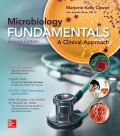
EBK MICROBIOLOGY FUNDAMENTALS: A CLINIC
2nd Edition
ISBN: 9781259293856
Author: Cowan
Publisher: MCGRAW HILL BOOK COMPANY
expand_more
expand_more
format_list_bulleted
Concept explainers
Textbook Question
Chapter 4.5, Problem 21AYP
Summarize the stages of a typical helminth life cycle.
Expert Solution & Answer
Want to see the full answer?
Check out a sample textbook solution
Students have asked these similar questions
a couple in which the father has the a blood type and the mother has the o blood type produce an offspring with the o blood type, how does this happen? how could two functionally O parents produce an offspring that has the a blood type?
What is the opening indicated by the pointer? (leaf x.s.)
stomate
guard cell
lenticel
intercellular space
none of these
Identify the indicated tissue? (stem x.s.)
parenchyma
collenchyma
sclerenchyma
○ xylem
○ phloem
none of these
Chapter 4 Solutions
EBK MICROBIOLOGY FUNDAMENTALS: A CLINIC
Ch. 4.1 - Relate bacterial, archaeal, and eukaryotic cells...Ch. 4.1 - List the types of eukaryotic microorganisms, and...Ch. 4.2 - List and describe the three main fibers of the...Ch. 4.2 - Prob. 1NPCh. 4.2 - Differentiate among the flagellar structures of...Ch. 4.2 - Prob. 4AYPCh. 4.2 - List similarities and differences between...Ch. 4.2 - Describe the main structural components of a...Ch. 4.2 - Diagram how the nucleus, endoplasmic reticulum,...Ch. 4.2 - Prob. 8AYP
Ch. 4.2 - Explain the importance of ribosomes, and...Ch. 4.3 - Prob. 11AYPCh. 4.3 - Prob. 12AYPCh. 4.3 - Differentiate among the terms heterotroph,...Ch. 4.3 - Prob. 14AYPCh. 4.3 - Prob. 15AYPCh. 4.4 - Prob. 16AYPCh. 4.4 - Prob. 17AYPCh. 4.4 - Explain why a cyst stage may be useful to a...Ch. 4.4 - Prob. 19AYPCh. 4.4 - Prob. 2NPCh. 4.5 - Prob. 20AYPCh. 4.5 - Summarize the stages of a typical helminth life...Ch. 4.5 - Prob. 3NPCh. 4 - Prob. 1CTCh. 4 - Prob. 1MCQCh. 4 - From chapter 2, figure 2.1. Discuss how the...Ch. 4 - Prob. 2CTCh. 4 - Prob. 2MCQCh. 4 - Prob. 3CTCh. 4 - Prob. 3MCQCh. 4 - Prob. 4CTCh. 4 - Prob. 4MCQCh. 4 - Prob. 5CTCh. 4 - Prob. 5MCQCh. 4 - Prob. 6MCQCh. 4 - Mitochondria likely originated from a. archaea. b....Ch. 4 - Prob. 8MCQ
Knowledge Booster
Learn more about
Need a deep-dive on the concept behind this application? Look no further. Learn more about this topic, biology and related others by exploring similar questions and additional content below.Similar questions
- Where did this structure originate from? (Salix branch root) epidermis cortex endodermis pericycle vascular cylinderarrow_forwardIdentify the indicated tissue. (Tilia stem x.s.) parenchyma collenchyma sclerenchyma xylem phloem none of thesearrow_forwardIdentify the indicated structure. (Cucurbita stem l.s.) pit lenticel stomate tendril none of thesearrow_forward
- Identify the specific cell? (Zebrina leaf peel) vessel element sieve element companion cell tracheid guard cell subsidiary cell none of thesearrow_forwardWhat type of cells flank the opening on either side? (leaf x.s.) vessel elements sieve elements companion cells tracheids guard cells none of thesearrow_forwardWhat specific cell is indicated. (Cucurbita stem I.s.) vessel element sieve element O companion cell tracheid guard cell none of thesearrow_forward
- Respond to the following in a minimum of 175 words: How might CRISPR-Cas 9 be used in research or, eventually, therapeutically in patients? What are some potential ethical issues associated with using this technology? Do the advantages of using this technology outweigh the disadvantages (or vice versa)? Explain your position.arrow_forwardYou are studying the effect of directional selection on body height in three populations (graphs a, b, and c below). (a) What is the selection differential? Show your calculation. (2 pts) (b) Which population has the highest narrow sense heritability for height? Explain your answer. (2 pts) (c) If you examined the offspring in the next generation in each population, which population would have the highest mean height? Why? (2 pts) (a) Midoffspring height (average height of offspring) Short Short Short Short (c) Short (b) Short Tall Short Tall Short Short Tall Midparent height (average height of Mean of population = 65 inches Mean of breading parents = 70 inches Mean of population = 65 inches Mean of breading parents = 70 inches Mean of population = 65 inches Mean of breading parents = 70 inchesarrow_forwardP You are studying a population of 100 flowers that has two alleles at a locus for flower color, blue (B) and green (G). There are 15 individuals with the BB genotype, 70 individuals with the BG genotype, and 15 individuals with the GG genotype. (a) What are the allele frequencies of B and G in the starting population? Show your calculations. (2 pts) (b) Is this population in Hardy-Weinberg equilibrium? Show your calculations. (3 pts) 12pt v Paragraph BIU UA AV & VT2V f CO Varrow_forward
arrow_back_ios
SEE MORE QUESTIONS
arrow_forward_ios
Recommended textbooks for you
 Biology (MindTap Course List)BiologyISBN:9781337392938Author:Eldra Solomon, Charles Martin, Diana W. Martin, Linda R. BergPublisher:Cengage Learning
Biology (MindTap Course List)BiologyISBN:9781337392938Author:Eldra Solomon, Charles Martin, Diana W. Martin, Linda R. BergPublisher:Cengage Learning
 Concepts of BiologyBiologyISBN:9781938168116Author:Samantha Fowler, Rebecca Roush, James WisePublisher:OpenStax College
Concepts of BiologyBiologyISBN:9781938168116Author:Samantha Fowler, Rebecca Roush, James WisePublisher:OpenStax College



Biology (MindTap Course List)
Biology
ISBN:9781337392938
Author:Eldra Solomon, Charles Martin, Diana W. Martin, Linda R. Berg
Publisher:Cengage Learning



Concepts of Biology
Biology
ISBN:9781938168116
Author:Samantha Fowler, Rebecca Roush, James Wise
Publisher:OpenStax College
General Embryology Review in 20 minutes; Author: Medical Animations;https://www.youtube.com/watch?v=4YKvVeVMmEE;License: Standard youtube license